Zyugan raspberry variety
Zyugana was bred by a team of breeders from the nursery of the Swiss company Lubera, led by Markus Kobelt, as part of a raspberry breeding program. In the city of Bux (Switzerland), the parent plants were crossed - Autumn Bliss and the famous Tulameen. The new variety was selected in experimental plantings back in 1999. It was at first asexual, and then reproduced by germinating uterine roots in bags to obtain seedlings, cutting shoots and rooting cuttings from them under the "fog" in a greenhouse. Ongoing observations of asexual reproductions of the new cultivar have confirmed that the distinctive features are clearly visible, remain stable and persist with subsequent reproduction. The first registrations of the "novelty" began in 2008. Thanks to this program, the well-known remontant large-fruited and productive variety Erika was also created.
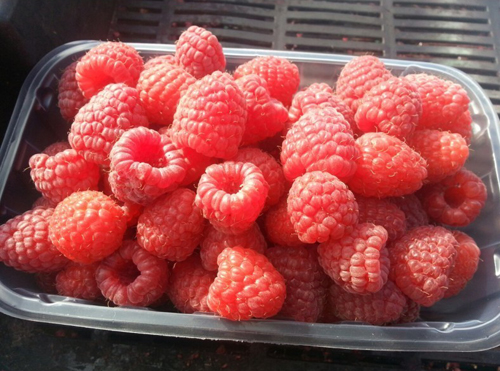
Description
Zyugana (Sugana) is a really full-fledged two timer, which means that the upper part of the raspberry shoot bears fruit in the first year, and the rest of the stem (after late autumn pruning of the spent part) yields the harvest already in the second year in the summer, mainly in early terms ... Moreover, both crops are full-fledged, a real totimer is able to grow them without prejudice to either of the two.

Shoots show growth from 1.5 to 2 meters, the bush itself is compact. With good agricultural technology in greenhouses, it can grow up to 2.5 meters. The stems of the variety are powerful, but not too thick, erect, covered with small purple thorns along the entire length. Flowering begins at the top and goes down along its entire length. The plant reproduces well, gives a lot of replacement shoots, but gives less side shoots than the same Polka and Erica. The leaves are large, light green in color. The root system is powerful, capable of providing food for two crops, demonstrates good frost resistance down to -35 ° C. Raspberries are also resistant to major crop diseases.
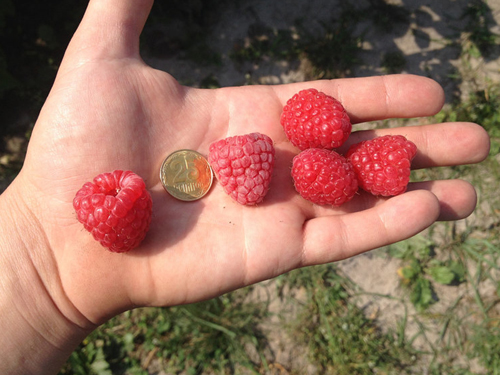
The berries are uniform, massive, wide, elongated-conical, bright red with an orange tint, shiny in the sun. The average weight in the season is mainly 5-6 grams, but there may be specimens up to 10 grams. Zyugana has a really rich taste - refreshing, rich raspberry. The berries are very sweet, aromatic, the pulp is juicy, and the skin is firm and elastic. The fruits are harder and lighter than those of the Shelf, outwardly they bear a resemblance to the berries of one of the parents - Tulamin. Drupes are well adhered, the berry does not crumble, demonstrating excellent transportability and keeping quality. Fruits are stored for up to 3 days without problems in cool rooms, and in the refrigerator they can generally lie for up to a week without losing marketability.

Zyugana is a versatile, not capricious, rather even a "problem-free" variety, which has been recognized many times as the best remontant in Europe. This raspberry can be safely called a "workhorse", bearing fruit stably in August, September and October without prejudice to the size of the fruit. It firmly endures various natural phenomena negative for plants: it does not crumble in the wind, with prolonged rains, damage to the fruits is insignificant, individual drupes can only rot, the sweetness does not disappear when the temperature drops and high humidity. The plant tolerates heat perfectly, the berries are practically not baked and retain their size. Also, with small frosts, the fruits retain their quality, especially if they are covered with leaves.
Medium-late variety, ripening one week later than Shelves. The beginning of fruiting on the shoots of the current year is in mid-late August, depending on the region of the country. When growing Zyugana in a one-year cycle, such a technique is also used to increase productivity - before flowering, the tops of raspberries are cut off, as a result of which the sides with laterals (fruit branches) are actively growing, and, therefore, more fruits are tied, but the very start of ripening is shifted to September.
If you leave the stems for summer fruiting, then its beginning will be from 10 June in the south, in more northern regions from the end of June, and the beginning of autumn fruiting is then shifted by 10-14 days. On average, the summer harvest is 2-3 kg per bush. In the summer-autumn turnover, in total, you can get up to 9 kg (in the southern regions and in closed ground), there fruiting lasts until December. There is information that with proper agricultural technology, and in particular with regular and full "feeding" of raspberries, the total yield of the variety in greenhouses reaches 12 kg per bush, with 7 to 10 stems in it.
In order not to list again all the indisputable and numerous advantages of Zyugana, it is necessary to indicate some disadvantages that must be taken into account when choosing raspberries.
Its main drawback is that in regions with an early onset of cold weather, cultivation is advisable in protected ground or only in a one-year cycle, otherwise most of the autumn harvest will simply freeze. Or it is better to plant a remontant with an earlier ripening period. In general, this is an excellent universal variety for both a large farm and an ordinary summer resident.
Yellow (gold) Zyugan
Many were waiting for this, and finally Yellow Sugana became available in our country. Why was she so desirable? Here's why. Indeed, in addition to the unusual color of the fruits, attractive both for buyers in the market and for ordinary lovers of eating raspberries on their site, especially if these lovers are children, the yellow cousins of red berries are even tastier and sweeter. Otherwise, the yellow-fruited plant is a mirror image of the red-fruited, repeating all its excellent characteristics.
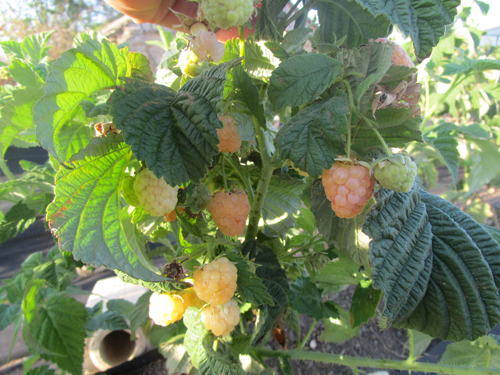
And here is a summary of her. On the plantings of the red-fruited variety, breeders of the same firm of Lyuber discovered and then selected for observation plants producing yellow berries. After fixing the varietal traits, the “novelty” was registered. It is almost a complete analogue of the Swiss remontant raspberry Zyugan, only it differs with its color. Her berries are bright yellow. And it seems to be even tastier and sweeter. Or maybe it's just self-hypnosis at the sight of such huge yellow beauties-berries. There is only one conclusion - plant both varieties and compare yourself. We are sure you will not go wrong!
Author: Maxim Zarechny.

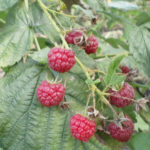
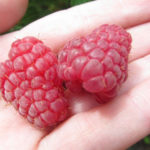

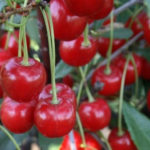
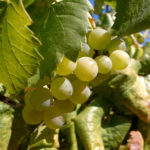



I have been growing Zyugan only for the first year, but I am already delighted with this berry!
I planted three bushes in the spring. They took root just fine, and already in August they pleased me with the first harvest. Moreover, the only thing I fed her with was an ash solution.
The berry is not just large - it's huge! But the branches are not as long as indicated: somewhere between 1 and 1.2 meters. Perhaps due to the fact that the bush is still young.
The only thing that is a little upsetting is the thorns. After all, when the bushes grow, they can significantly complicate the collection of berries.